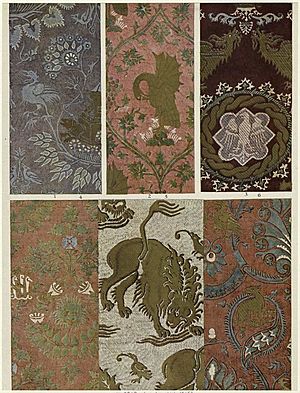Damask facts for kids
Damask is a special type of fabric with patterns woven into it. It's often made from silk or wool. This fabric is known for its beautiful, classic designs. The way damask is made uses a unique weaving method. The first damask fabrics came from places like the Ottoman Empire, Syria, Iran, and Jordan.
The Story of Damask Fabric
Damask fabric has a long and interesting history. It was first created during the Middle Ages using one of five main weaving methods. This special fabric was very popular in the Byzantine Empire and in Islamic regions. The name "Damask" comes from the city of Damascus, which is where this weaving style and its patterns were first developed.
After the 9th century, damask became less common in most places, except for Andalusia (a region in Spain). However, European weavers later became very interested in the beautiful designs from the Middle East. They started making damask on their own weaving machines from the 14th century onwards. This helped damask become popular again in Europe.
Damask Today
Today, damask patterns are still used, but they are often made on modern computer-controlled weaving machines. While the original damask fabrics often had many colors, most modern damask is made in just one color. This means the pattern shows up because of how the light reflects off the fabric, not because of different colors.
Damask is now woven using materials like silk, linen, and even man-made materials. The patterns can show things like plants, flowers, and fruits. You might also see other classic Arabian designs. A cool thing about damask is that the pattern looks different when you look at it from various angles. This is because of how the light bounces off the woven threads.
Images for kids
-
Damask used as a tablecloth. A water droplet sits on top because damask doesn't absorb much water.
See also
 In Spanish: Damasco (tejido) para niños
In Spanish: Damasco (tejido) para niños




